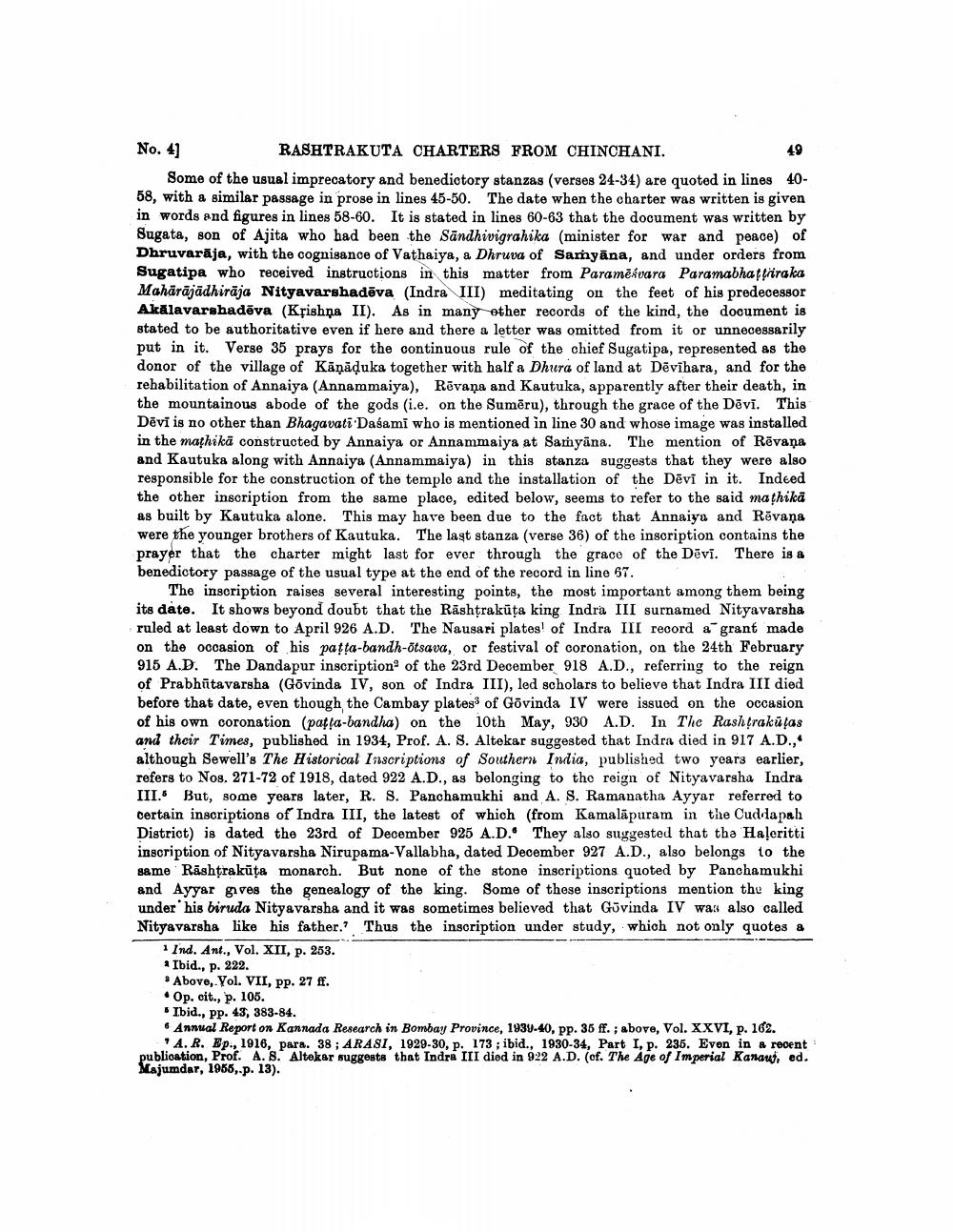________________
No. 41
RASHTRAKUTA CHARTERS FROM CHINCHANI. Some of the usual imprecatory and benedictory stanzas (verses 24-34) are quoted in lines 4058, with a similar passage in prose in lines 45-50. The date when the charter was written is given in words and figures in lines 58-60. It is stated in lines 60-63 that the document was written by Sugata, son of Ajita who had been the Sandhivigrahika (minister for war and peace) of Dhruvarāja, with the cognisance of Vathaiya, a Dhruva of Samyāna, and under orders from Sugatipa who received instructions in this matter from Paramēšvara Paramabhatçriraka Mahārājādhirāja Nityavarshadēva (Indra III) meditating on the feet of his predecessor Akālavarshadēva (Kfishna II). As in many other records of the kind, the document is stated to be authoritative even if here and there a letter was omitted from it or unnecessarily put in it. Verse 35 prays for the continuous rule of the chief Sugatipa, represented as the donor of the village of Kāņāduka together with half a Dhura of land at Dēvihara, and for the rehabilitation of Annaiya (Annammaiya), Rēvana and Kautuka, apparently after their death, in the mountainous abode of the gods (i.e. on the Sumēru), through the grace of the Dēvi. This Dēvi is no other than Bhagavati Dasami who is mentioned in line 30 and whose image was installed in the mathika constructed by Annaiya or Annammaiya at Saryana. The mention of Rēvana and Kautuka along with Annaiya (Annammaiya) in this stanza suggests that they were also responsible for the construction of the temple and the installation of the Dēvi in it. Indeed the other inscription from the same place, edited below, seems to refer to the said mathika as built by Kautuka alone. This may have been due to the fact that Annaiya and Rēvaņa were the younger brothers of Kautuka. The last stanza (verse 36) of the inscription contains the prayer that the charter might last for ever through the grace of the Dēvī. There is a benedictory passage of the usual type at the end of the record in line 67.
The inscription raises several interesting points, the most important among them being its date. It shows beyond doubt that the Rashtrakūta king Indra III surnamed Nityavarsha ruled at least down to April 926 A.D. The Nausari plates of Indra III record a grant made on the occasion of his patta-bandh-otsava, or festival of coronation, on the 24th February 915 A.D. The Dandapur inscription of the 23rd December 918 A.D., referring to the reign of Prabhitavarsha (Govinda IV, son of Indra III), led scholars to believe that Indra III died before that date, even though the Cambay plates of Govinda IV were issued on the occasion of his own coronation (paffa-bandha) on the 10th May, 930 A.D. In The Rashtrakūtas and their Times, published in 1934, Prof. A. S. Altekar suggested that Indra died in 917 A.D.,. although Sewell's The Historical Inscriptions of Southern India, published two years earlier, refers to Nos. 271-72 of 1918, dated 922 A.D., as belonging to the reign of Nityavarsha Indra III. But, some years later, R. S. Panchamukhi and A. S. Ramanatha Ayyar referred to certain inscriptions of Indra III, the latest of which (from Kamalapuram in the Cuddapah District) is dated the 23rd of December 925 A.D. They also suggested that the Haleritti inscription of Nityavarsha Nirupama-Vallabha, dated December 927 A.D., also belongs to the game Rāshtrakūta monarch. But none of the stone inscriptions quoted by Panchamukhi and Ayyar gives the genealogy of the king. Some of these inscriptions mention the king under his biruda Nityavarsha and it was sometimes believed that Govinda IV was also called Nityavarsha like his father.' Thus the inscription under study, which not only quotes a
1 Ind. Ant., Vol. XII, p. 253. * Ibid., p. 222. * Above, Vol. VII, pp. 27 ff. • Op. cit., p. 105. * Ibid., pp. 43, 383-84. 6 Annual Report on Kannada Research in Bombay Province, 1939-40, pp. 35 ff. ; above, Vol. XXVI, p. 162.
4. R. Ep., 1916, para. 38; ARASI, 1929-30, p. 173 ; ibid., 1930-34, Part I, p. 235. Even in a recent publioation, Prof. A. 8. Altekar suggests that Indra III died in 922 A.D. (cf. The Age of Imperial Kanaus, ed. Majumdar, 1966, p. 13).




